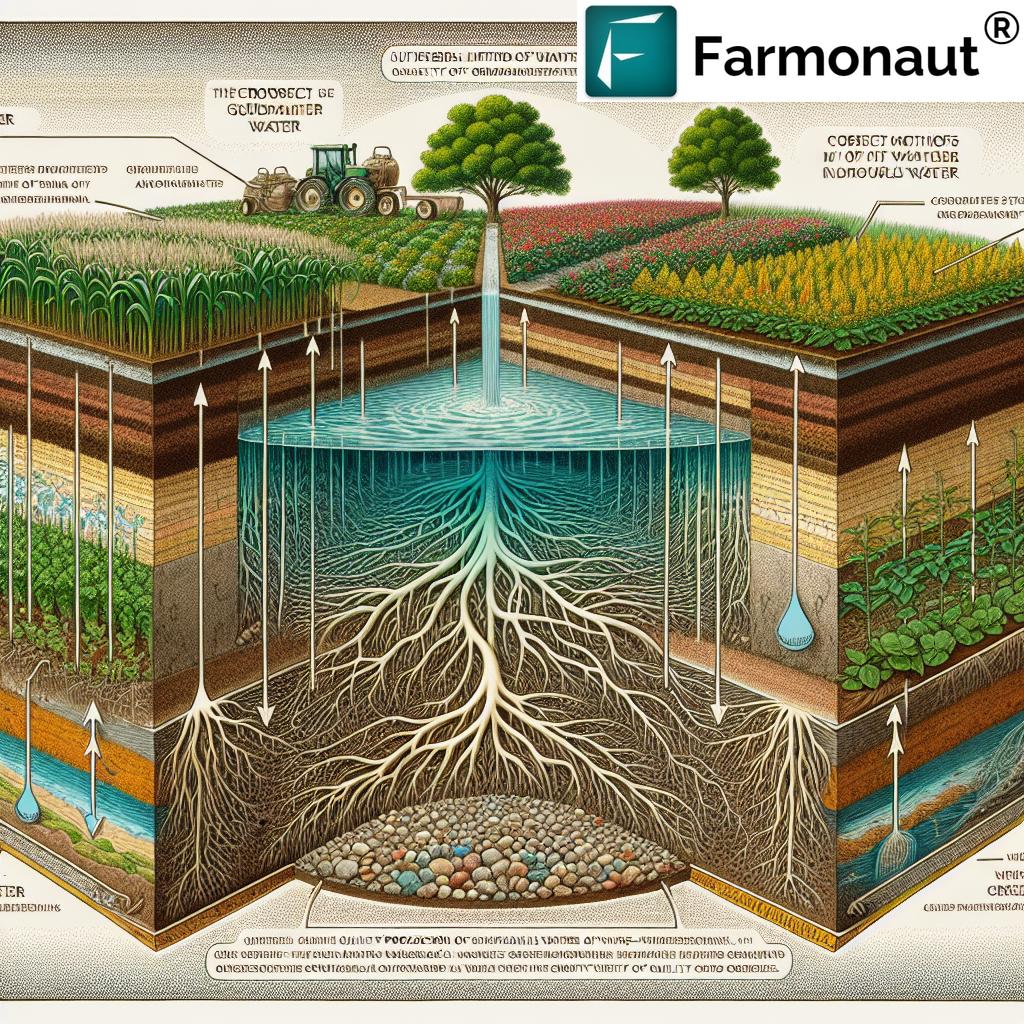Revolutionizing Water Quality Management: Auburn’s New Agricultural Guidelines for Sustainable Farming Practices
“Auburn’s new watershed ordinance requires existing farms to implement waste and nutrient management plans by 2027.”
In the ever-evolving landscape of sustainable agriculture, we find ourselves at a crucial juncture where water quality management in agriculture takes center stage. The recent developments in Auburn, Maine, have brought this issue to the forefront, highlighting the delicate balance between agricultural productivity and environmental stewardship. As we delve into the intricacies of Auburn’s new agricultural guidelines, we’ll explore how these changes are set to revolutionize sustainable farming practices and how cutting-edge technology can play a pivotal role in this transformation.
Understanding the New Watershed Ordinance Amendments
On a Monday that will be remembered as a turning point for Lake Auburn’s future, the Auburn City Council took decisive action by approving a series of amendments to the watershed ordinance. With a resounding 6-1 vote, the council demonstrated its commitment to enhancing water quality protections for this vital resource. These amendments represent a significant shift in focus, moving beyond previous measures that primarily addressed development concerns to now tackle the complex relationship between agricultural activities and water quality.
The newly approved changes stem from the diligent work of an ad hoc committee dedicated to safeguarding Lake Auburn’s water quality. While earlier ordinance modifications concentrated on curbing development, updating septic system standards, and implementing inspection protocols, these latest amendments zero in on the agricultural sector’s impact within the watershed area.
Key Elements of the New Guidelines
- Enhanced Buffer Zones: Larger buffer zones around agricultural operations near wetlands
- Stricter Controls: More rigorous oversight of fertilizer and pesticide use
- Clear-Cutting Regulations: New limitations on clear-cutting practices
- Waste and Nutrient Management: Mandatory plans for farms with specific wetland buffer requirements
It’s crucial to note that while these changes aim to protect water quality, they do not prohibit farming within the watershed. Instead, they establish stringent guidelines that require careful planning and management from agricultural operators.

Timeline and Implementation
One of the most significant aspects of these amendments is the timeline for implementation. Existing farms within the watershed are required to develop and submit waste or nutrient management plans by June 30, 2027. This deadline provides a clear target for farmers to align their practices with the new regulations while allowing sufficient time for adaptation and planning.
The ordinance also introduces immediate changes to manure management practices:
- Prohibition on manure spreading without adequate storage measures
- Prevention of manure runoff contaminating groundwater
- New guidelines for responsible fertilizer and pesticide use
- Restrictions on clear-cutting practices
These immediate changes underscore the urgency of addressing water quality concerns while recognizing the need for a phased approach to more complex adjustments in farming practices.
The Role of Technology in Sustainable Farming
As we navigate these new regulations, it’s clear that technology will play a crucial role in helping farmers adapt and thrive. This is where innovative solutions like those offered by Farmonaut come into play. By leveraging satellite-based farm management tools, farmers can gain valuable insights into their land use, crop health, and resource management – all essential components in meeting the new guidelines.
Farmonaut’s platform provides real-time crop health monitoring, AI-based advisory systems, and resource management tools that can significantly aid farmers in:
- Optimizing fertilizer and pesticide use
- Monitoring soil health and moisture levels
- Implementing effective buffer zone management
- Developing comprehensive nutrient management plans
By utilizing such advanced technologies, farmers can not only comply with the new regulations but also enhance their overall farm productivity and sustainability.
Balancing Agricultural Productivity and Environmental Protection
“The recent amendments focus on three key areas: enhancing buffer zones, nutrient management plans, and wetland protection.”
The crux of Auburn’s new guidelines lies in finding the delicate balance between maintaining agricultural productivity and protecting the environment. This balance is essential for sustainable farming practices that can support long-term food security while preserving water quality and ecosystem health.
Buffer Zones: A Natural Barrier
The implementation of larger buffer zones around agricultural operations near wetlands serves multiple purposes:
- Filtering runoff and reducing pollutant load in water bodies
- Providing habitat for wildlife and promoting biodiversity
- Stabilizing soil and preventing erosion
- Creating a transition zone between agricultural land and sensitive ecosystems
By enhancing these buffer zones, the new guidelines aim to create a natural barrier that protects water quality without significantly impacting farm productivity.
Nutrient Management Plans: Precision in Practice
The requirement for nutrient management plans is a cornerstone of the new regulations. These plans are designed to:
- Optimize fertilizer application based on crop needs and soil conditions
- Minimize nutrient runoff and leaching into water bodies
- Improve soil health and fertility over time
- Reduce unnecessary costs associated with over-application of fertilizers
By implementing these plans, farmers can achieve better crop yields while significantly reducing their environmental impact.

Wetland Protection: Preserving Vital Ecosystems
The focus on wetland protection in the new guidelines recognizes the critical role these ecosystems play in:
- Filtering and purifying water
- Providing habitat for diverse plant and animal species
- Mitigating flood risks
- Recharging groundwater supplies
By safeguarding wetlands within watersheds, the amendments ensure that these natural water quality management systems continue to function effectively.
Technological Solutions for Compliance and Efficiency
As farmers work to adapt to these new guidelines, technological solutions become increasingly valuable. Farmonaut’s suite of tools offers comprehensive support for sustainable farming practices and water quality management in agriculture.
Satellite-Based Crop Health Monitoring
Farmonaut’s satellite imagery technology provides farmers with real-time insights into:
- Vegetation health (NDVI)
- Soil moisture levels
- Early detection of pest and disease issues
This information is crucial for making informed decisions about irrigation, fertilizer usage, and pest management, all of which directly impact water quality and farm efficiency.
AI-Driven Advisory System
The Jeevn AI advisory system offered by Farmonaut delivers:
- Personalized farm management recommendations
- Real-time weather forecasts and alerts
- Expert crop management strategies
These AI-driven insights can help farmers optimize their practices in line with the new guidelines, ensuring compliance while maximizing productivity.
Resource Management Tools
Farmonaut’s platform includes tools for:
- Precise fertilizer and pesticide application planning
- Water usage optimization
- Soil health monitoring
These tools are invaluable for developing and implementing the waste and nutrient management plans required by the new ordinance.
Comparative Analysis: New Guidelines vs. Technological Solutions
| New Auburn Agricultural Guidelines | Farmonaut’s Supporting Solutions | Implementation Deadline | Estimated Environmental Impact |
|---|---|---|---|
| Buffer Zone Management | Satellite imagery for precise land mapping and monitoring | Immediate | High |
| Nutrient Management Plans | AI-driven advisory system for optimized fertilizer application | June 30, 2027 | High |
| Fertilizer and Pesticide Control | Precision application planning tools | Immediate | Medium |
| Manure Storage and Application | Resource management tools for waste tracking | Immediate | High |
| Wetland Protection | Satellite-based wetland monitoring and mapping | Immediate | High |
This comparative analysis clearly demonstrates how technological solutions like those provided by Farmonaut can directly support farmers in meeting the new guidelines while enhancing overall farm management and environmental protection.
Challenges and Opportunities
While the new guidelines present challenges for farmers, they also open up opportunities for innovation and improvement in agricultural practices.
Challenges:
- Initial costs of implementing new management practices
- Learning curve associated with adopting new technologies
- Potential short-term reduction in cultivable land due to expanded buffer zones
Opportunities:
- Improved long-term soil health and productivity
- Reduced input costs through optimized resource use
- Enhanced farm resilience to climate change impacts
- Potential for premium pricing on sustainably produced crops
By leveraging technological solutions, farmers can more easily navigate these challenges and capitalize on the opportunities presented by the new guidelines.
The Future of Sustainable Farming in Auburn and Beyond
As we look to the future, the agricultural guidelines implemented in Auburn could serve as a model for other communities seeking to balance agricultural productivity with environmental protection. The integration of advanced technologies in farming practices is likely to play an increasingly important role in achieving this balance.
Potential Long-term Impacts:
- Improved water quality in Lake Auburn and surrounding watersheds
- Increased biodiversity in agricultural landscapes
- More resilient farming systems capable of withstanding climate challenges
- Enhanced public trust in local agricultural practices
By embracing these changes and leveraging technological solutions, Auburn’s agricultural community is poised to become a leader in sustainable farming practices, setting an example for regions around the world.
How Farmonaut Can Help
As farmers in Auburn and beyond work to adapt to new regulations and embrace sustainable practices, Farmonaut’s suite of tools offers comprehensive support:
- Precision Agriculture: Satellite-based crop monitoring for optimized resource use
- AI-Driven Insights: Personalized recommendations for crop management and compliance
- Resource Management: Tools for efficient water, fertilizer, and pesticide use
- Data-Driven Decision Making: Real-time analytics to support farm management decisions
By utilizing these advanced technologies, farmers can not only meet regulatory requirements but also enhance their overall farm productivity and sustainability.
Explore Farmonaut’s API for customized solutions: Farmonaut API
For developers looking to integrate Farmonaut’s capabilities: API Developer Docs
Conclusion
The new agricultural guidelines implemented in Auburn represent a significant step forward in the quest for sustainable farming practices and improved water quality management in agriculture. By focusing on key areas such as buffer zone enhancement, nutrient management plans, and wetland protection, these regulations set a new standard for environmental stewardship in the agricultural sector.
While the transition to these new practices may present challenges, the long-term benefits for both farmers and the environment are substantial. With the support of advanced technological solutions like those offered by Farmonaut, farmers have the tools they need to navigate this transition successfully, optimizing their operations while protecting vital water resources.
As we move forward, the integration of sustainable farming practices and cutting-edge agricultural technology will be crucial in meeting the growing demand for food production while safeguarding our natural resources. Auburn’s initiative serves as a beacon, illuminating the path towards a more sustainable and resilient agricultural future.
FAQs
- Q: When do existing farms need to implement waste and nutrient management plans?
A: Existing farms within the Auburn watershed are required to develop and submit these plans by June 30, 2027. - Q: Are farmers still allowed to operate within the watershed under the new guidelines?
A: Yes, farming is still permitted within the watershed, but under stricter guidelines that require specific management plans and buffer zones. - Q: How can technology help farmers comply with the new regulations?
A: Technologies like Farmonaut’s satellite-based monitoring and AI-driven advisory systems can help farmers optimize resource use, implement precise management plans, and monitor compliance with buffer zone requirements. - Q: What are the main focus areas of the new amendments?
A: The amendments primarily focus on enhancing buffer zones, implementing nutrient management plans, and protecting wetlands within watersheds. - Q: How do these changes affect manure management practices?
A: The new regulations prohibit manure spreading without adequate storage measures and require practices that prevent manure runoff from contaminating groundwater.






